Study on the Water Quality Characteristics of the Baoan Lake Basin in China under Different Land Use and Landscape Pattern Distributions
Abstract
:1. Introduction
2. Materials and Methods
2.1. Overview of the Study Area and Sample Locations
2.2. Sample Collection and Measurement
2.3. Land-Use Data
2.4. Landscape Pattern Data
2.5. Data Processing
3. Results
3.1. Status of Land Use and Landscape Pattern in the Baoan Lake Basin
3.2. Water Quality Characteristics of the Lakes and Rivers Entering the Lake
3.3. Relationship between Land Use, Landscape Pattern, and Water Quality in the Basin
4. Discussion
4.1. Influence of the Land-Use Type on Water Quality in the Baoan Lake Basin
4.2. Influence of the Landscape Pattern on Water Quality in the Baoan Lake Basin
4.3. Influence of Different Offshore Scales on Water Quality
5. Conclusions
Author Contributions
Funding
Institutional Review Board Statement
Informed Consent Statement
Data Availability Statement
Conflicts of Interest
References
- Wang, Y.; Zhou, X.; Engel, B. Water environment carrying capacity in Bosten Lake basin. J. Clean. Prod. 2018, 199, 574–583. [Google Scholar]
- Chen, Y.; Cao, Y.; Tang, S.; Huang, H.; Qi, J. Study on water level ecological amplitude of Typha orientalis seedlings. J. Freshw. Ecol. 2021, 36, 293–304. [Google Scholar] [CrossRef]
- Lu, P.; Wang, H.; Chen, P.; Storozum, M.J.; Xu, J.; Tian, Y.; Mo, D.; Wang, S.; He, Y.; Yan, L. The impact of Holocene alluvial landscape evolution on an ancient settlement in the southeastern piedmont of Songshan Mountain, Central China: A study from the Shiyuan site. Catena 2019, 183, 104232. [Google Scholar] [CrossRef]
- Li, S.; Gu, S.; Liu, W.; Han, H.; Zhang, Q. Water quality in relation to land use and land cover in the upper Han River Basin, China. Catena 2008, 75, 216–222. [Google Scholar] [CrossRef]
- Maguire, T.J.; Wellen, C.; Stammler, K.L.; Mundle, S.O. Increased nutrient concentrations in Lake Erie tributaries influenced by greenhouse agriculture. Sci. Total Environ. 2018, 633, 433–440. [Google Scholar] [CrossRef] [PubMed]
- Rimal, B.; Sharma, R.; Kunwar, R.; Keshtkar, H.; Stork, N.E.; Rijal, S.; Rahman, S.A.; Baral, H. Effects of land use and land cover change on ecosystem services in the Koshi River Basin, Eastern Nepal. Ecosyst. Serv. 2019, 38, 100963. [Google Scholar] [CrossRef]
- Li, X. A review of the international researches on land use/land cover change. Acta Geogr. Sin. 1996, 51, 553–558, (In Chinese with English Abstract). [Google Scholar]
- Aneseyee, A.B.; Elias, E.; Soromessa, T.; Feyisa, G.L. Land use/land cover change effect on soil erosion and sediment delivery in the Winike watershed, Omo Gibe Basin, Ethiopia. Sci. Total Environ. 2020, 728, 138776. [Google Scholar] [CrossRef]
- Ebabu, K.; Tsunekawa, A.; Haregeweyn, N.; Adgo, E.; Meshesha, D.T.; Aklog, D.; Masunaga, T.; Tsubo, M.; Sultan, D.; Fenta, A.A.; et al. Effects of land use and sustainable land management practices on runoff and soil loss in the Upper Blue Nile basin, Ethiopia. Sci. Total Environ. 2019, 648, 1462–1475. [Google Scholar] [CrossRef]
- Liu, J.; Shen, Z.; Yan, T.; Yang, Y. Source identification and impact of landscape pattern on riverine nitrogen pollution in a typical urbanized watershed, Beijing, China. Sci. Total Environ. 2018, 628–629, 1296–1307. [Google Scholar] [CrossRef]
- Shrestha, S.; Bhatta, B.; Shrestha, M.; Shrestha, P.K. Integrated assessment of the climate and landuse change impact on hydrology and water quality in the Songkhram River Basin, Thailand. Sci. Total Environ. 2018, 643, 1610–1622. [Google Scholar] [CrossRef]
- Xu, J.; Jin, G.; Tang, H.; Mo, Y.; Wang, Y.; Li, L. Response of water quality to land use and sewage outfalls in different seasons. Sci. Total Environ. 2019, 696, 134014. [Google Scholar] [CrossRef]
- Wang, Y.; Yang, G.; Li, B.; Wang, C.; Su, W. Measuring the zonal responses of nitrogen output to landscape pattern in a flatland with river network: A case study in Taihu Lake Basin, China. Environ. Sci. Pollut. Res. 2022, 29, 34624–34636. [Google Scholar] [CrossRef] [PubMed]
- Luo, Z.; Shao, Q.; Zuo, Q.; Cui, Y. Impact of land use and urbanization on river water quality and ecology in a dam dominated basin. J. Hydroecol. 2020, 584, 124655. [Google Scholar] [CrossRef]
- Rather, I.A.; Dar, A.Q. Assessing the impact of land use and land cover dynamics on water quality of Dal Lake, NW Himalaya, India. Appl. Water Sci. 2020, 10, 219. [Google Scholar] [CrossRef]
- Nobre, R.L.G.; Caliman, A.; Cabral, C.R.; Araújo, F.D.C.; Guérin, J.; Dantas, F.D.C.C.; Quesado, L.B.; Venticinque, E.M.; Guariento, R.D.; Amado, A.M.; et al. Precipitation, landscape properties and land use interactively affect water quality of tropical freshwaters. Sci. Total Environ. 2020, 716, 137044. [Google Scholar] [CrossRef]
- Liu, J.; Shen, Z.; Chen, L. Assessing how spatial variations of land use pattern affect water quality across a typical urbanized watershed in Beijing, China. Landsc. Urban Plan. 2018, 176, 51–63. [Google Scholar] [CrossRef]
- Li, Y.; Wright, A.; Liu, H.; Wang, J.; Wang, G.; Wu, Y.; Dai, L. Land use pattern, irrigation, and fertilization effects of rice-wheat rotation on water quality of ponds by using self-organizing map in agricultural watersheds. Agric. Ecosyst. Environ. 2019, 272, 155–164. [Google Scholar] [CrossRef]
- Mello, K.D.; Valente, R.A.; Randhir, T.O.; Dos Santos, A.C.A.; Vettorazzi, C.A. Effects of land use and land cover on water quality of low-order streams in Southeastern Brazil: Watershed versus riparian zone. Catena 2018, 167, 130–138. [Google Scholar] [CrossRef]
- Rodrigues, V.; Estrany, J.; Ranzini, M.; De Cicco, V.; Martín-benito, J.M.T.; Hedo, J.; Lucas-borja, M.E. Effects of land use and seasonality on stream water quality in a small tropical catchment: The headwater of Córrego Água Limpa, São Paulo (Brazil). Sci. Total Environ. 2018, 622–623, 1553–1561. [Google Scholar] [CrossRef] [Green Version]
- Gu, Q.; Hu, H.; Ma, L.; Sheng, L.; Yang, S.; Zhang, X.; Zhang, M.; Zheng, K.; Chen, L. Characterizing the spatial variations of the relationship between land use and surface water quality using self-organizing map approach. Ecol. Indic. 2019, 102, 633–643. [Google Scholar] [CrossRef]
- Shi, P.; Zhang, Y.; Li, Z.; Li, P.; Xu, G. Influence of land use and land cover patterns on seasonal water quality at multi-spatial scales. Catena 2017, 151, 182–190. [Google Scholar] [CrossRef]
- He, X.; Chen, C.; He, M.; Chen, Q.; Zhang, J.; Li, G.; Wang, Z.; Mao, Y.; Dong, J. Landscape index for indicating water quality and application to master plan of regional lake cluster restoration. Ecol. Indic. 2021, 126, 107668. [Google Scholar] [CrossRef]
- Wu, J.; Lu, J. Spatial scale effects of landscape metrics on stream water quality and their seasonal changes. Water Res. 2021, 191, 116811. [Google Scholar] [CrossRef] [PubMed]
- Zhang, J.; Li, S.; Jiang, C. Effects of land use on water quality in a River Basin (Daning) of the Three Gorges Reservoir Area, China: Watershed versus riparian zone. Ecol. Indic. 2020, 113, 106226. [Google Scholar] [CrossRef]
- Wu, J.; Lu, J. Landscape patterns regulate non-point source nutrient pollution in an agricultural watershed. Sci. Total Environ. 2019, 669, 377–388. [Google Scholar] [CrossRef] [PubMed]
- Compilation Committee for the Records of Lakes in Hubei Province. The Records of Lakes in Hubei Province; Hubei Science & Technology Press: Wuhan, China, 2015; 518p. (In Chinese) [Google Scholar]
- Editional Board of Water and Wastewater Monitoring and Analysis Methods, Ministry of Environmental Potection of the People’s Republic of China. Water and Wastewater Monitoring and Analysis Methods, 4th ed.; China Environmental Science Press: Beijing, China, 2002; pp. 105–610. (In Chinese) [Google Scholar]
- Mello, K.D.; Valente, R.A.; Randhir, T.O.; Vettorazzi, C.A. Impacts of tropical forest cover on water quality in agricultural watersheds in southeastern Brazil. Ecol. Indic. 2018, 93, 1293–1301. [Google Scholar] [CrossRef]
- Alnahit, A.O.; Mishra, A.K.; Khan, A.A. Stream water quality prediction using boosted regression tree and random forest models. Stoch. Environ. Res. Risk Assess. 2022. [Google Scholar] [CrossRef]
- Ren, W.; Wu, X.; Yang, J.; Luo, L.; Liang, S.; Yang, H. Water pollution characteristics of inflowing rivers under different land-use patterns in the Daye Lake basin: Pollution mode and management suggestions. Environ. Monit. Assess. 2022, 194, 10. [Google Scholar] [CrossRef]
- Fraterrigo, J.M.; Downing, J.A. The influence of land use on lake nutrients varies with watershed transport capacity. Ecosystems 2008, 11, 1021–1034. [Google Scholar] [CrossRef]
- Beaver, J.R.; Manis, E.E.; Loftin, K.A.; Graham, J.L.; Pollard, A.I.; Mitchell, R.M. Land use patterns, ecoregion, and microcystin relationships in U.S. lakes and reservoirs: A preliminary evaluation. Harmful Algae 2014, 36, 57–62. [Google Scholar] [CrossRef]
- Macintosh, K.A.; Mayer, B.K.; Mcdowell, R.W.; Powers, S.M.; Baker, L.A.; Boyer, T.H.; Rittmann, B.E. Managing diffuse phosphorus at the source versus at the sink. Environ. Sci. Technol. 2018, 52, 11995–12009. [Google Scholar] [CrossRef] [PubMed] [Green Version]
- Silva, L.V.B.; Vasconcelos, H.L.; Mack, M.C.; Ferreira, A.D.S.; Bruna, E.M. Effects of experimental nitrogen enrichment on soil properties and litter decomposition in a Neotropical savanna. Austral Ecol. 2020, 45, 1093–1102. [Google Scholar] [CrossRef]
- Xu, J.; Wu, X.; Ge, X.; Tian, Y.; Ma, X.; Li, Y.; Xu, X.; Li, Z. Variations of concentration characteristics of rainfall runoff pollutants in typical urban living areas. Bull. Environ. Contam. Toxicol. 2021, 106, 608–613. [Google Scholar] [CrossRef] [PubMed]
- Perera, T.; Mcgree, J.; Egodawatta, P.; Jinadasa, K.; Goonetilleke, A. A Bayesian approach to model the trends and variability in urban stormwater quality associated with catchment and hydrologic parameters. Water Res. 2021, 197, 117076. [Google Scholar] [CrossRef] [PubMed]
- Ding, J.; Jiang, Y.; Fu, L.; Liu, Q.; Peng, Q.; Kang, M. Impacts of land use on surface water quality in a subtropical river basin: A case study of the Dongjiang River basin, southeastern China. Water 2015, 7, 4427–4445. [Google Scholar] [CrossRef] [Green Version]
- Zhang, J.; Li, S.; Dong, R.; Jiang, C.; Ni, M. Influences of land use metrics at multi-spatial scales on seasonal water quality: A case study of river systems in the Three Gorges Reservoir Area, China. J. Cleaner Prod. 2019, 206, 76–85. [Google Scholar] [CrossRef]
- Xu, S.; Li, S.; Zhong, J.; Li, C. Spatial scale effects of the variable relationships between landscape pattern and water quality: Example from an agricultural karst river basin, Southwestern China. Agric. Ecosyst. Environ. 2020, 300, 106999. [Google Scholar] [CrossRef]
- Giri, S.; Qiu, Z.; Zhang, Z. Assessing the impacts of land use on downstream water quality using a hydrologically sensitive area concept. J. Environ. Manag. 2018, 213, 309–319. [Google Scholar] [CrossRef]
- Yao, Y.; Zhang, S.; Shi, Y.; Xu, M.; Zhang, J.; Zhang, Y.; Zhao, J. Landscape pattern change of impervious surfaces and its driving forces in Shanghai during 1965–2010. Water 2021, 13, 1956. [Google Scholar] [CrossRef]
- Bin, L.; Xu, K.; Xu, X.; Lian, J.; Ma, C. Development of a landscape indicator to evaluate the effect of landscape pattern on surface runoff in the Haihe River Basin. J. Hydroecol. 2018, 566, 546–557. [Google Scholar] [CrossRef]
- Ruan, X.; Huang, J.; Williams, D.A.; Harker, K.J.; Gergel, S.E. High spatial resolution landscape indicators show promise in explaining water quality in urban streams. Ecol. Indic. 2019, 103, 321–330. [Google Scholar] [CrossRef]
- Zhu, C.; Zhang, X.; Zhou, M.; He, S.; Gan, M.; Yang, L.; Wang, K. Impacts of urbanization and landscape pattern on habitat quality using OLS and GWR models in Hangzhou, China. Ecol. Indic. 2020, 117, 106654. [Google Scholar] [CrossRef]
- Han, Y.; Chang, D.; Xiang, X.; Wang, J. Can ecological landscape pattern influence dry-wet dynamics? A national scale assessment in China from 1980 to 2018. Sci. Total Environ. 2022, 823, 153587. [Google Scholar] [CrossRef] [PubMed]
- Mainali, J.; Chang, H. Landscape and anthropogenic factors affecting spatial patterns of water quality trends in a large river basin, South Korea. J. Hydroecol. 2018, 564, 26–40. [Google Scholar] [CrossRef]
- Xu, Q.; Wang, P.; Shu, W.; Ding, M.; Zhang, H. Influence of landscape structures on river water quality at multiple spatial scales: A case study of the Yuan river watershed, China. Ecol. Indic. 2021, 121, 107226. [Google Scholar] [CrossRef]
- Nash, M.S.; Heggem, D.T.; Ebert, D.; Wade, T.G.; Hall, R.K. Multi-scale landscape factors influencing stream water quality in the state of Oregon. Environ. Monit. Assess. 2009, 156, 343–360. [Google Scholar] [CrossRef]
- Ding, J.; Jiang, Y.; Liu, Q.; Hou, Z.; Liao, J.; Fu, L.; Peng, Q. Influences of the land use pattern on water quality in low-order streams of the Dongjiang River basin, China: A multi-scale analysis. Sci. Total Environ. 2016, 551–552, 205–216. [Google Scholar] [CrossRef]
- Peng, S.; Li, S. Scale relationship between landscape pattern and water quality in different pollution source areas: A case study of the Fuxian Lake watershed, China. Ecol. Indic. 2021, 121, 107136. [Google Scholar] [CrossRef]
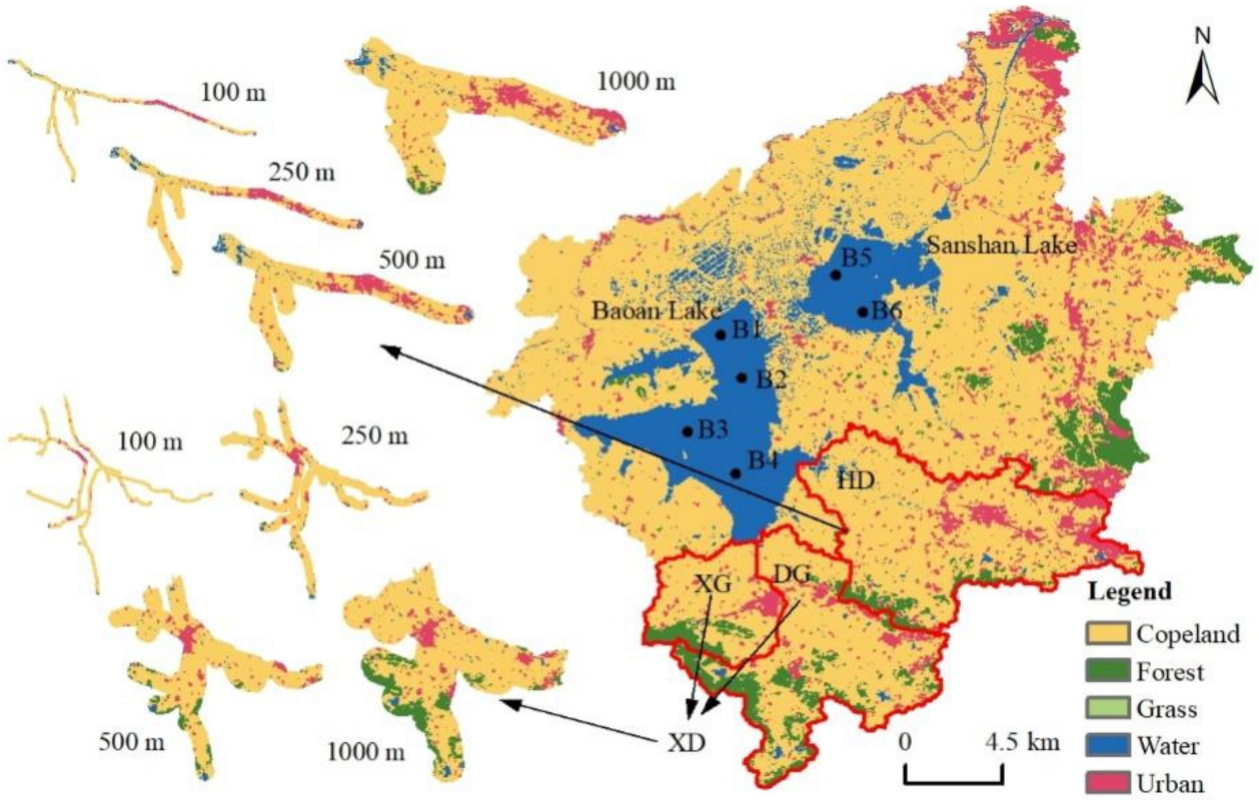

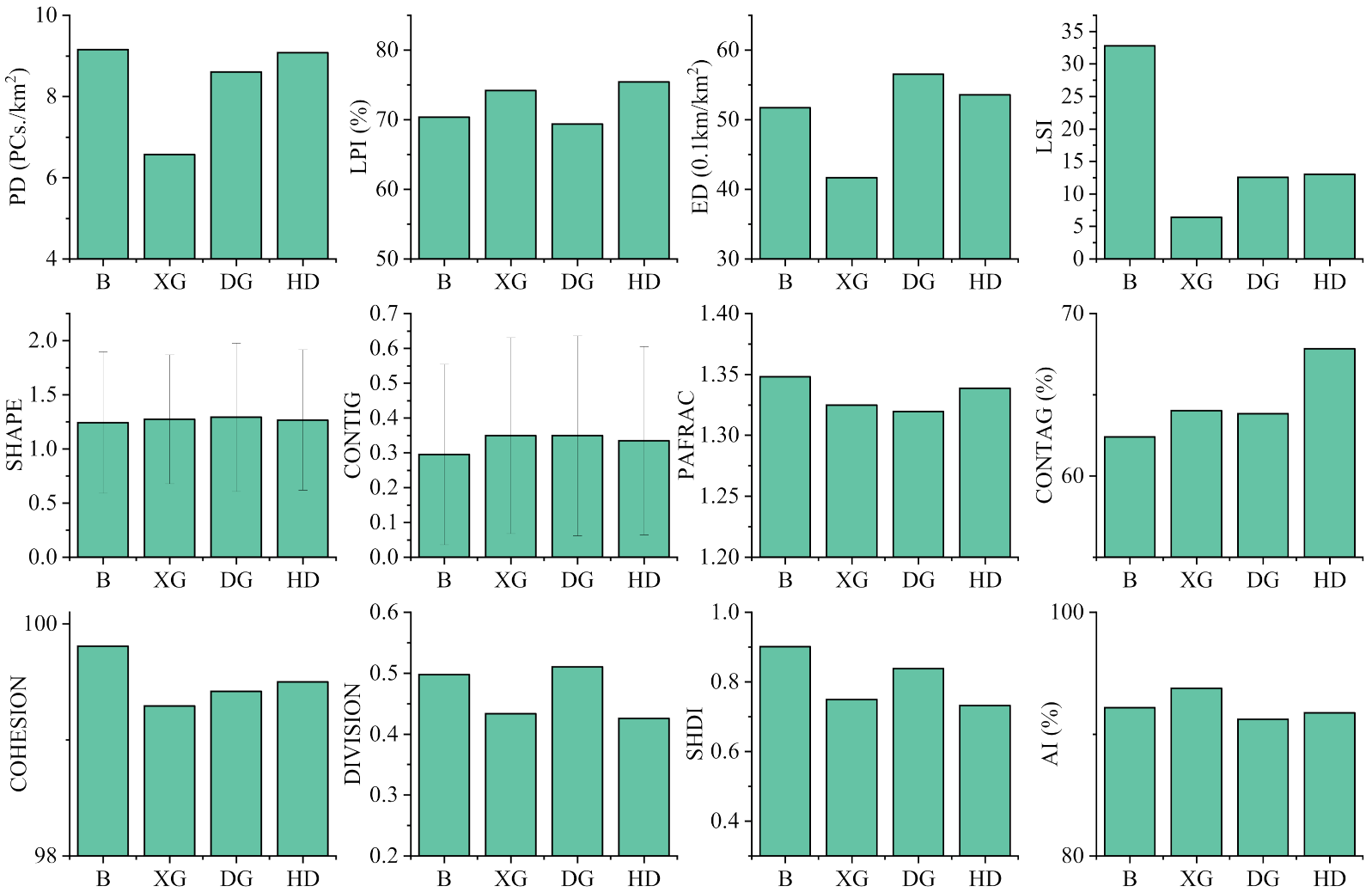
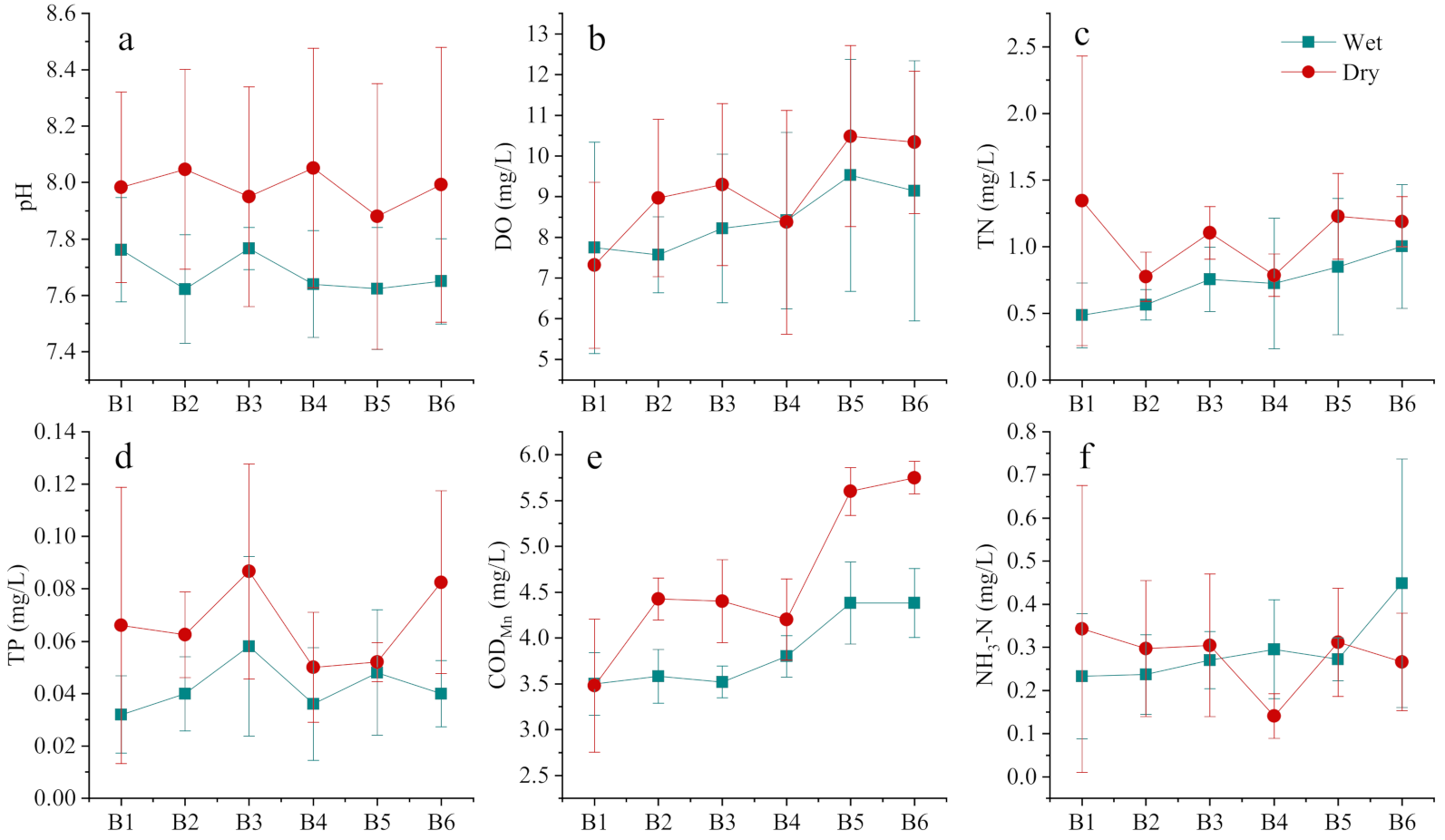

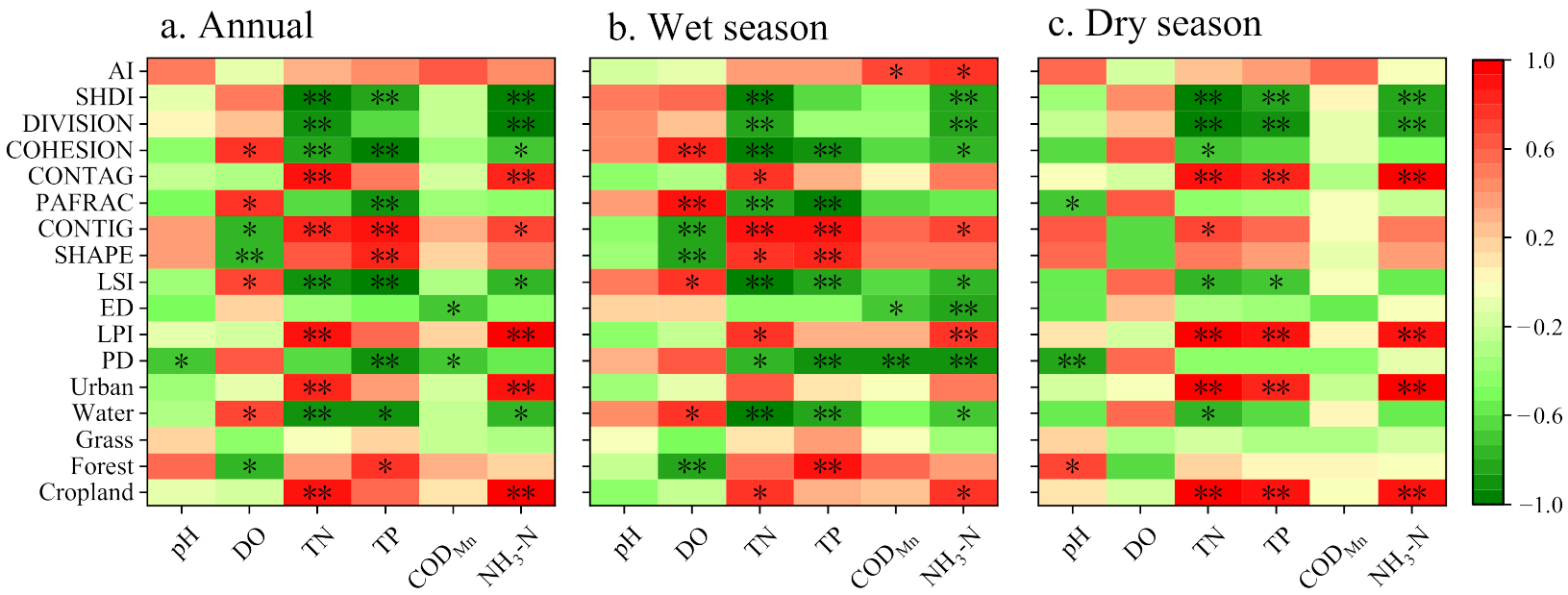
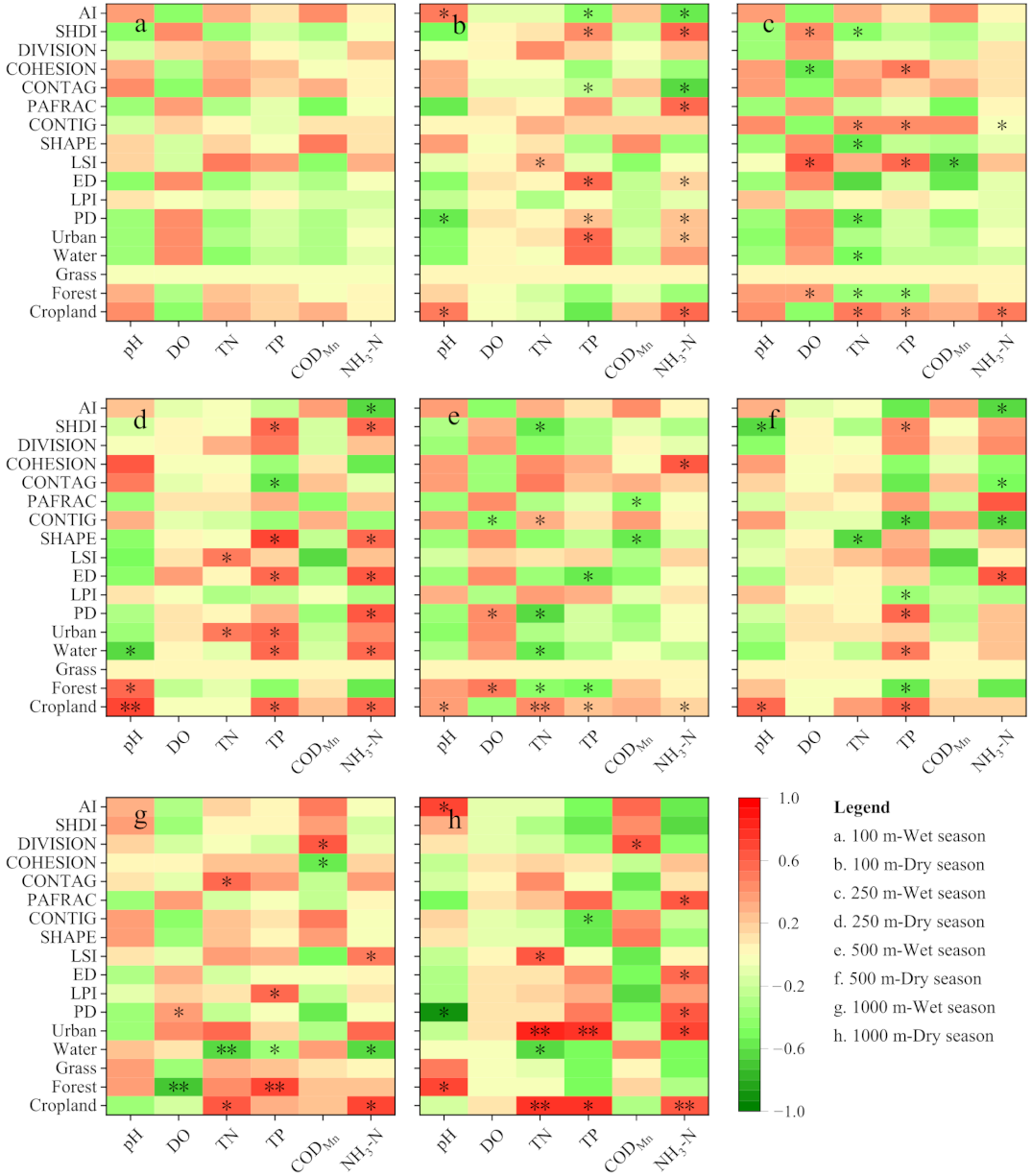
| Name | Acronym | Describe | Unit |
|---|---|---|---|
| patch density | PD | Number of landscape patches per unit area. | PCs/km2 |
| largest patch index | LPI | Proportion of the largest patch in the landscape area. | % |
| edge density | ED | The ratio of the total length of patch boundary to the landscape area. | 0.1 km/km2 |
| landscape shape index | LSI | The degree of deviation between the shape of a patch in the area and a circle or square of the same area | - |
| shape index | SHAPE | The mean value of the ratio between the perimeter of the patch and the square root of the area in the region. | - |
| contiguity index | CONTIG | Refers to the proximity between patches. | - |
| perimeter-area fractal dimension | PAFRAC | Calculation method of landscape patch regression degree. | - |
| contagion | CONTAG | Describes the degree of agglomeration of each patch type. | % |
| patch cohesion index | COHESION | Measures the physical connectivity of patch types. | - |
| landscape division index | DIVISION | The closer the value is to 1, the more serious the degree of landscape segmentation. | - |
| Shannon’s diversity index | SHDI | Measures the diversity of patch types in the landscape. | - |
| aggregation index | AI | Describes the degree of aggregation of spatial patterns. | % |
| Cropland | Forest | Grass | Water | Urban | |
|---|---|---|---|---|---|
| B | 71.18% | 6.19% | 0.013% | 14.11% | 8.48% |
| XG | 75.23% | 14.14% | 0.000% | 0.50% | 10.11% |
| DG | 70.26% | 20.15% | 0.074% | 1.33% | 8.17% |
| HD | 77.21% | 6.38% | 0.014% | 1.89% | 14.49% |
Publisher’s Note: MDPI stays neutral with regard to jurisdictional claims in published maps and institutional affiliations. |
© 2022 by the authors. Licensee MDPI, Basel, Switzerland. This article is an open access article distributed under the terms and conditions of the Creative Commons Attribution (CC BY) license (https://creativecommons.org/licenses/by/4.0/).
Share and Cite
Ren, W.; Wu, X.; Ge, X.; Lin, G.; Feng, L.; Ma, W.; Xu, D. Study on the Water Quality Characteristics of the Baoan Lake Basin in China under Different Land Use and Landscape Pattern Distributions. Int. J. Environ. Res. Public Health 2022, 19, 6082. https://doi.org/10.3390/ijerph19106082
Ren W, Wu X, Ge X, Lin G, Feng L, Ma W, Xu D. Study on the Water Quality Characteristics of the Baoan Lake Basin in China under Different Land Use and Landscape Pattern Distributions. International Journal of Environmental Research and Public Health. 2022; 19(10):6082. https://doi.org/10.3390/ijerph19106082
Chicago/Turabian StyleRen, Weixiang, Xiaodong Wu, Xuguang Ge, Guiying Lin, Lian Feng, Wanqing Ma, and Dan Xu. 2022. "Study on the Water Quality Characteristics of the Baoan Lake Basin in China under Different Land Use and Landscape Pattern Distributions" International Journal of Environmental Research and Public Health 19, no. 10: 6082. https://doi.org/10.3390/ijerph19106082
APA StyleRen, W., Wu, X., Ge, X., Lin, G., Feng, L., Ma, W., & Xu, D. (2022). Study on the Water Quality Characteristics of the Baoan Lake Basin in China under Different Land Use and Landscape Pattern Distributions. International Journal of Environmental Research and Public Health, 19(10), 6082. https://doi.org/10.3390/ijerph19106082







